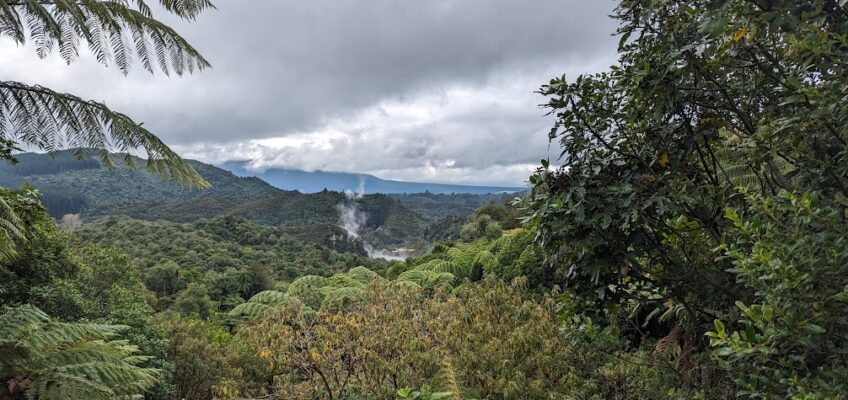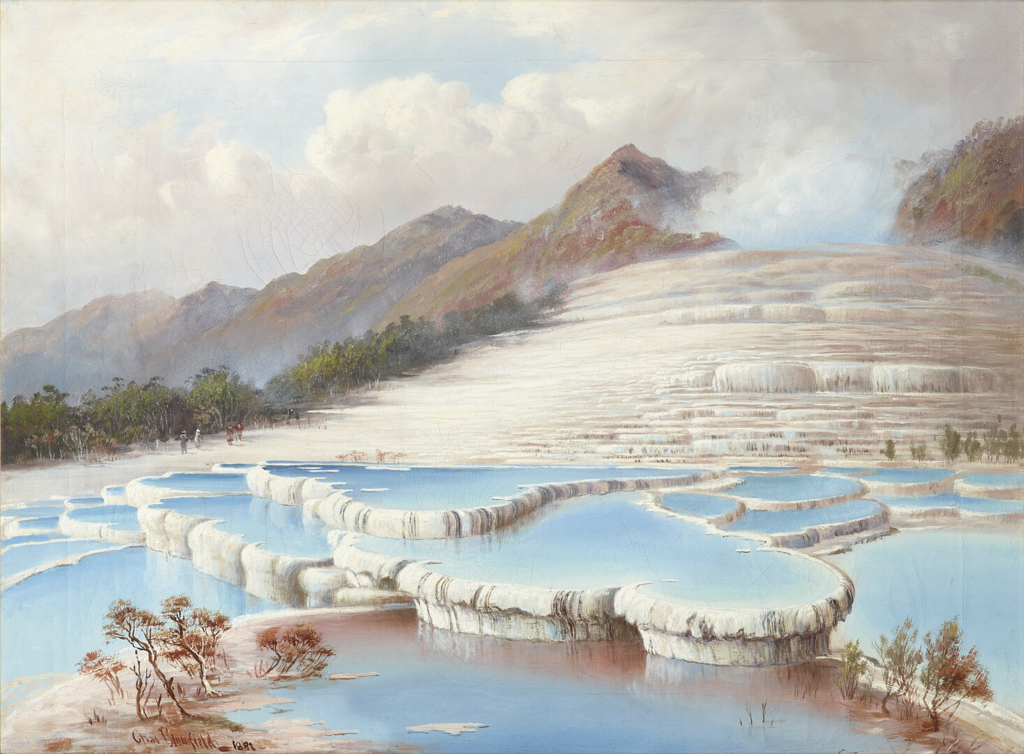This morning we left Rotorua and flew to Christchurch. Before I forget everything, here’s a rundown of the activities, sights, and experiences of Rotorua.
If you don’t want to read about them, you can skip ahead to the photos:
- Redwood Memorial Grove and Treewalk
- Waimangu Volcanic Valley
- Everything else Rotorua (including the Dinner Theatre)
Redwoods
Did you know there are Californian Redwoods in New Zealand? I didn’t.
Giant redwoods and sequoias were planted in the Whakarewarewa Forest, on the outskirts of Rotorua in 1901. The hope was that they would be viable for the commercial timber industry. But the results were mixed, and only 6 hectares (less than 15 acres) survived. But those that survived did very well due to the rich volcanic soil, favourable climate and high rainfall in the area. In fact, they grew faster in New Zealand than in the United States, and reached heights of over 70 meters (230 feet) in just 100 years. This is now a protected forest area, forming the Redwood Memorial Grove, dedicated to those who worked in the state forestry service and were killed in the two world wars.
We did a short walk through the Whakarewarewa Forest after we arrived in Rotorua. Later, after dark, we did the Redwoods Treewalk, enjoying colorful lights illuminating the trees as we crossed a network of hanging bridges through the canopy.
Lake Rotorua
The next day we did the pōwhiri (which I wrote about already). When we got back, I decided to take a walk and explore Rotorua a little.
I ended up on the shore of Lake Rotorua, and I ended up doing a two-hour walk along the lake. This was such a delight! In addition to the much-needed exercise, the birds and the views of the lake were fabulous.
Then there was an area called Sulphur Point. In addition to lots more birds, there was a series of (smelly) geothermal pools.
Waimangu Volcanic Valley
On our last day in Rotorua we visited the Waimangu Volcanic Valley. This was actually an optional trip add-on, but it should be an included activity, as it was one of the most interesting things we’ve done.
Starting in the 1820s, tourists came to visit Lake Rotomahana and see the geothermal features, including the famous pink and white terraces along the edge of the lake.
On June 10, 1886, nearby Mount Tarawera erupted. As a result, the pink and white terraces were destroyed, all living things in the area were killed, including 120 residents who lived nearby, Lake Rotomahana grew to twenty times its previous size, and seven craters also erupted, creating new hot springs.
In 1900, a geyser began erupting. It was named “Waimangu,” meaning “black water.” This is how the area got its name. For four years, Waimangu Geyser was the largest in the world, but in 1904 the eruptions stopped.
Life began to return to Waimangu around 1915. Further eruptions have taken place over the years, the most recent in 2016.
This is the area we visited. We hiked through the valley, past the various hot springs, and then took a boat ride on Lake Rotomahana.
Dinner Theatre
A regular feature of OAT tours is a home-hosted dinner. This is a chance to visit a family in their home and learn about their culture while we share a meal with them.
On my previous OAT trips, the home-hosted dinners were intimate opportunities for interaction with our host families. In the Sacred Valley of Peru we bought food at a local market and helped prepare it. On other trips, we sat around together with our hosts and chatted, asking questions and answering their questions.
Our home-hosted dinner with a Māori family in Rotorua was a vastly different experience. It was a show.
First, we arrived and met the husband and wife and took seats in their living room. There are sixteen of us on this tour, and they had no problem accommodating all of us. This was clearly a well-to-do middle class family that happened to have Māori roots. The wife gave us her pepeha and then told us a little about her background. She attended college in the United States on a full-ride basketball scholarship. She teaches at a Māori school.
Then her husband told us about himself. He was a timber truck driver until recently. He quit because he didn’t get to spend enough time with his family. Now he works as a teacher’s aide at a school.
Then we went around and introduced ourselves with our names and where we are from.
We also met two of their three daughters, one 15 and one 6. (Later we met the 2‑year-old.) The oldest girl told us about her four trips abroad.
Then it was time to eat dinner. They didn’t eat with us, but watched us all eat and chatted with us. Then they put on a little show.
After the show, they invited us to get dessert, and while we had dessert (pavlova and hokey-pokey ice cream) the wife then showed us a video of performances by children at her school on their 86-inch flat-screen TV (which you can see on the wall in the videos above).
Finally it was time to go, and we all said good-bye with traditional Māori hongi (touching noses).
I don’t mean to suggest that this was not an enjoyable experience. It was fascinating and entertaining, and the family members were genuinely warm and engaging. But it did feel like attending a dinner theatre. The wife told us that they had another group last night and will have yet another tomorrow, not just from OAT but from various tour groups. They clearly have rehearsed this production and it operates like a well-oiled machine.
So that pretty much sums up our visit to Rotorua. Don’t forget to check out the photos if you haven’t yet.




Timothy Welch
Thanks for the continued stories and photographs. I agree, the Waimangu Volcanic Valley, was very exciting. But, yum, Hokey Pokey Ice Cream!
Tim
Lane
Hokey Pokey is okay, but it’s not chocolate,so just okay.
Thanks for reading!